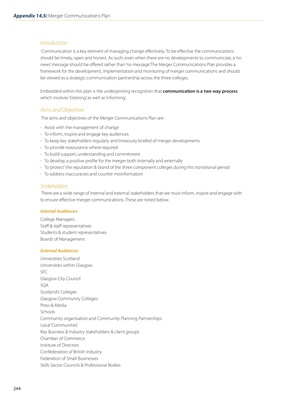
244
Appendix 14.5: Merger Communications Plan
Introduction
Communication is a key element of managing change ef ectively. To be ef ective the communications
should be timely, open and honest. As such, even when there are no developments to communicate, a 'no
news' message should be of ered rather than 'no message'.The Merger Communications Plan provides a
framework for the development, implementation and monitoring of merger communications and should
be viewed as a strategic communication partnership across the three colleges.
Embedded within this plan is the underpinning recognition that communication is a two way process
which involves 'listening' as well as 'informing'.
Aims and Objectives
The aims and objectives of the Merger Communications Plan are:
Assist with the management of change
To inform, inspire and engage key audiences
To keep key stakeholders regularly and timeously briefed of merger developments
To provide reassurance where required
To build support, understanding and commitment
To develop a positive proi le for the merger both internally and externally
To 'protect' the reputation & brand of the three component colleges during this transitional period
To address inaccuracies and counter misinformation
Stakeholders
There are a wide range of internal and external stakeholders that we must inform, inspire and engage with
to ensure ef ective merger communications. These are noted below.
Internal Audiences
College Managers
Staf & staf representatives
Students & student representatives
Boards of Management
External Audiences
Universities Scotland
Universities within Glasgow
SFC
Glasgow City Council
SQA
Scotland's Colleges
Glasgow Community Colleges
Press & Media
Schools
Community organisation and Community Planning Partnerships
Local 'Communities'
Key Business & Industry stakeholders & client groups
Chamber of Commerce
Institute of Directors
Confederation of British Industry
Federation of Small Businesses
Skills Sector Councils & Professional Bodies
•
•
•
•
•
•
•
•